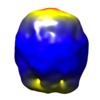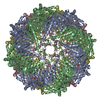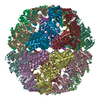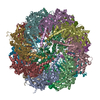[English] 日本語
 Yorodumi
Yorodumi- EMDB-5641: cryo-EM structure of CCT5 complex with 1mM ATP/AlFx (symmetry-free) -
+ Open data
Open data
- Basic information
Basic information
| Entry | Database: EMDB / ID: EMD-5641 | |||||||||
|---|---|---|---|---|---|---|---|---|---|---|
| Title | cryo-EM structure of CCT5 complex with 1mM ATP/AlFx (symmetry-free) | |||||||||
 Map data Map data | symmetry-free reconstruction of CCT5 complex | |||||||||
 Sample Sample |
| |||||||||
 Keywords Keywords | TRiC / CCT /  chaperonin / chaperonin /  protein folding / protein folding /  cryo-electron microscopy cryo-electron microscopy | |||||||||
| Function / homology |  Function and homology information Function and homology informationpositive regulation of protein localization to Cajal body / positive regulation of establishment of protein localization to telomere / BBSome-mediated cargo-targeting to cilium / chaperonin-containing T-complex / Folding of actin by CCT/TriC / positive regulation of telomerase RNA localization to Cajal body / Formation of tubulin folding intermediates by CCT/TriC / binding of sperm to zona pellucida / Prefoldin mediated transfer of substrate to CCT/TriC /  beta-tubulin binding ...positive regulation of protein localization to Cajal body / positive regulation of establishment of protein localization to telomere / BBSome-mediated cargo-targeting to cilium / chaperonin-containing T-complex / Folding of actin by CCT/TriC / positive regulation of telomerase RNA localization to Cajal body / Formation of tubulin folding intermediates by CCT/TriC / binding of sperm to zona pellucida / Prefoldin mediated transfer of substrate to CCT/TriC / beta-tubulin binding ...positive regulation of protein localization to Cajal body / positive regulation of establishment of protein localization to telomere / BBSome-mediated cargo-targeting to cilium / chaperonin-containing T-complex / Folding of actin by CCT/TriC / positive regulation of telomerase RNA localization to Cajal body / Formation of tubulin folding intermediates by CCT/TriC / binding of sperm to zona pellucida / Prefoldin mediated transfer of substrate to CCT/TriC /  beta-tubulin binding / Association of TriC/CCT with target proteins during biosynthesis / chaperone-mediated protein folding / protein folding chaperone / positive regulation of telomere maintenance via telomerase / mRNA 3'-UTR binding / ATP-dependent protein folding chaperone / response to virus / mRNA 5'-UTR binding / Cooperation of PDCL (PhLP1) and TRiC/CCT in G-protein beta folding / G-protein beta-subunit binding / unfolded protein binding / beta-tubulin binding / Association of TriC/CCT with target proteins during biosynthesis / chaperone-mediated protein folding / protein folding chaperone / positive regulation of telomere maintenance via telomerase / mRNA 3'-UTR binding / ATP-dependent protein folding chaperone / response to virus / mRNA 5'-UTR binding / Cooperation of PDCL (PhLP1) and TRiC/CCT in G-protein beta folding / G-protein beta-subunit binding / unfolded protein binding /  protein folding / protein folding /  cell body / cell body /  microtubule / protein stabilization / microtubule / protein stabilization /  centrosome / centrosome /  nucleolus / nucleolus /  ATP hydrolysis activity / extracellular exosome / ATP hydrolysis activity / extracellular exosome /  ATP binding / ATP binding /  cytosol / cytosol /  cytoplasm cytoplasmSimilarity search - Function | |||||||||
| Biological species |   Homo sapiens (human) Homo sapiens (human) | |||||||||
| Method |  single particle reconstruction / single particle reconstruction /  cryo EM cryo EM | |||||||||
 Authors Authors | Sergeeva OA / Chen B / Haase-Pettingell C / Ludtke SJ / Chiu W / King JA | |||||||||
 Citation Citation |  Journal: J Biol Chem / Year: 2013 Journal: J Biol Chem / Year: 2013Title: Human CCT4 and CCT5 chaperonin subunits expressed in Escherichia coli form biologically active homo-oligomers. Authors: Oksana A Sergeeva / Bo Chen / Cameron Haase-Pettingell / Steven J Ludtke / Wah Chiu / Jonathan A King /  Abstract: Chaperonins are a family of chaperones that encapsulate their substrates and assist their folding in an ATP-dependent manner. The ubiquitous eukaryotic chaperonin, TCP-1 ring complex (TRiC), is a ...Chaperonins are a family of chaperones that encapsulate their substrates and assist their folding in an ATP-dependent manner. The ubiquitous eukaryotic chaperonin, TCP-1 ring complex (TRiC), is a hetero-oligomeric complex composed of two rings, each formed from eight different CCT (chaperonin containing TCP-1) subunits. Each CCT subunit may have distinct substrate recognition and ATP hydrolysis properties. We have expressed each human CCT subunit individually in Escherichia coli to investigate whether they form chaperonin-like double ring complexes. CCT4 and CCT5, but not the other six CCT subunits, formed high molecular weight complexes within the E. coli cells that sedimented about 20S in sucrose gradients. When CCT4 and CCT5 were purified, they were both organized as two back-to-back rings of eight subunits each, as seen by negative stain and cryo-electron microscopy. This morphology is consistent with that of the hetero-oligomeric double-ring TRiC purified from bovine testes and HeLa cells. Both CCT4 and CCT5 homo-oligomers hydrolyzed ATP at a rate similar to human TRiC and were active as assayed by luciferase refolding and human γD-crystallin aggregation suppression and refolding. Thus, both CCT4 and CCT5 homo-oligomers have the property of forming 8-fold double rings absent the other subunits, and these complexes carry out chaperonin reactions without other partner subunits. | |||||||||
| History |
|
- Structure visualization
Structure visualization
| Movie |
 Movie viewer Movie viewer |
|---|---|
| Structure viewer | EM map:  SurfView SurfView Molmil Molmil Jmol/JSmol Jmol/JSmol |
| Supplemental images |
- Downloads & links
Downloads & links
-EMDB archive
| Map data |  emd_5641.map.gz emd_5641.map.gz | 9.8 MB |  EMDB map data format EMDB map data format | |
|---|---|---|---|---|
| Header (meta data) |  emd-5641-v30.xml emd-5641-v30.xml emd-5641.xml emd-5641.xml | 11.5 KB 11.5 KB | Display Display |  EMDB header EMDB header |
| Images |  emd_5641.png emd_5641.png | 106.8 KB | ||
| Archive directory |  http://ftp.pdbj.org/pub/emdb/structures/EMD-5641 http://ftp.pdbj.org/pub/emdb/structures/EMD-5641 ftp://ftp.pdbj.org/pub/emdb/structures/EMD-5641 ftp://ftp.pdbj.org/pub/emdb/structures/EMD-5641 | HTTPS FTP |
-Related structure data
- Links
Links
| EMDB pages |  EMDB (EBI/PDBe) / EMDB (EBI/PDBe) /  EMDataResource EMDataResource |
|---|---|
| Related items in Molecule of the Month |
- Map
Map
| File |  Download / File: emd_5641.map.gz / Format: CCP4 / Size: 26.4 MB / Type: IMAGE STORED AS FLOATING POINT NUMBER (4 BYTES) Download / File: emd_5641.map.gz / Format: CCP4 / Size: 26.4 MB / Type: IMAGE STORED AS FLOATING POINT NUMBER (4 BYTES) | ||||||||||||||||||||||||||||||||||||||||||||||||||||||||||||||||||||
|---|---|---|---|---|---|---|---|---|---|---|---|---|---|---|---|---|---|---|---|---|---|---|---|---|---|---|---|---|---|---|---|---|---|---|---|---|---|---|---|---|---|---|---|---|---|---|---|---|---|---|---|---|---|---|---|---|---|---|---|---|---|---|---|---|---|---|---|---|---|
| Annotation | symmetry-free reconstruction of CCT5 complex | ||||||||||||||||||||||||||||||||||||||||||||||||||||||||||||||||||||
| Voxel size | X=Y=Z: 2.16 Å | ||||||||||||||||||||||||||||||||||||||||||||||||||||||||||||||||||||
| Density |
| ||||||||||||||||||||||||||||||||||||||||||||||||||||||||||||||||||||
| Symmetry | Space group: 1 | ||||||||||||||||||||||||||||||||||||||||||||||||||||||||||||||||||||
| Details | EMDB XML:
CCP4 map header:
| ||||||||||||||||||||||||||||||||||||||||||||||||||||||||||||||||||||
-Supplemental data
- Sample components
Sample components
-Entire : CCT5 Complex
| Entire | Name: CCT5 Complex |
|---|---|
| Components |
|
-Supramolecule #1000: CCT5 Complex
| Supramolecule | Name: CCT5 Complex / type: sample / ID: 1000 / Oligomeric state: hexadecamer / Number unique components: 1 |
|---|---|
| Molecular weight | Experimental: 1 MDa / Theoretical: 960 KDa / Method: size exclusion column (Superose 6 10/300 GL) |
-Macromolecule #1: chaperonin containing TCP1, subunit 5 (epsilon)
| Macromolecule | Name: chaperonin containing TCP1, subunit 5 (epsilon) / type: protein_or_peptide / ID: 1 / Name.synonym: CCT5 / Number of copies: 16 / Oligomeric state: Hexadecamer / Recombinant expression: Yes |
|---|---|
| Source (natural) | Organism:   Homo sapiens (human) / synonym: Human Homo sapiens (human) / synonym: Human |
| Molecular weight | Experimental: 1 MDa / Theoretical: 960 KDa |
| Recombinant expression | Organism:   Escherichia coli (E. coli) / Recombinant strain: BL21(DE3) RIL / Recombinant plasmid: pET21b Escherichia coli (E. coli) / Recombinant strain: BL21(DE3) RIL / Recombinant plasmid: pET21b |
| Sequence | UniProtKB: T-complex protein 1 subunit epsilon GO:  nucleolus, nucleolus,  cytoplasm, cytoplasm,  centrosome, centrosome,  cytosol, chaperonin-containing T-complex cytosol, chaperonin-containing T-complexInterPro: T-complex protein 1, epsilon subunit, Chaperone tailless complex polypeptide 1 (TCP-1), Chaperonin TCP-1, conserved site, Chaperonin Cpn60/GroEL/TCP-1 family |
-Experimental details
-Structure determination
| Method |  cryo EM cryo EM |
|---|---|
 Processing Processing |  single particle reconstruction single particle reconstruction |
| Aggregation state | particle |
- Sample preparation
Sample preparation
| Concentration | 0.35 mg/mL |
|---|---|
| Buffer | pH: 7.4 Details: 20 mM HEPES/KOH, pH 7.4, 200 mM NaCl, 1 mM DTT, 10 mM MgCl2, 5% glycerol, 5 mM Al(NO3)3, 30 mM NaF, 1 mM ATP |
| Grid | Details: plasma-cleaned R1.2/1.3 Quantifoil grid |
| Vitrification | Cryogen name: ETHANE / Chamber humidity: 100 % / Instrument: FEI VITROBOT MARK III Method: Front side blotting for 4 seconds twice before plunging |
- Electron microscopy
Electron microscopy
| Microscope | JEOL 2010F |
|---|---|
| Electron beam | Acceleration voltage: 200 kV / Electron source:  FIELD EMISSION GUN FIELD EMISSION GUN |
| Electron optics | Calibrated magnification: 71361 / Illumination mode: FLOOD BEAM / Imaging mode: BRIGHT FIELD Bright-field microscopy / Cs: 2.0 mm / Nominal defocus max: 3.5 µm / Nominal defocus min: 1.5 µm / Nominal magnification: 50000 Bright-field microscopy / Cs: 2.0 mm / Nominal defocus max: 3.5 µm / Nominal defocus min: 1.5 µm / Nominal magnification: 50000 |
| Specialist optics | Energy filter - Name: Gatan in-column energy filter |
| Sample stage | Specimen holder: This holder operates at -178 C (95K). / Specimen holder model: GATAN LIQUID NITROGEN |
| Temperature | Min: 94.98 K / Max: 95 K / Average: 94.99 K |
| Alignment procedure | Legacy - Astigmatism: Objective lens astigmatism was corrected at 250,000 times magnification |
| Details | MDS mode imaging was used. |
| Date | Mar 26, 2012 |
| Image recording | Category: CCD / Film or detector model: GENERIC GATAN (4k x 4k) / Average electron dose: 20 e/Å2 / Camera length: 120 |
- Image processing
Image processing
| CTF correction | Details: each frame |
|---|---|
| Final two d classification | Number classes: 67 |
| Final reconstruction | Algorithm: OTHER / Software - Name: EMAN1 / Details: filtered back-projection / Number images used: 2974 |
| Details | 6,307 particles (ATP-AlFx state) were boxed out semi-automatically using e2boxer.py. The later steps of 3D reconstruction were performed using EMAN1. |
 Movie
Movie Controller
Controller
















